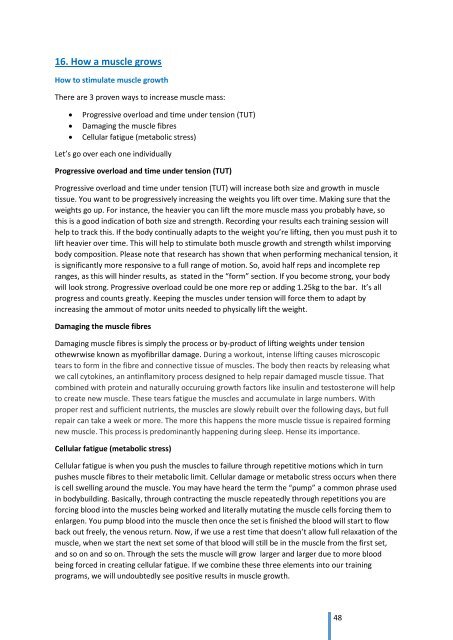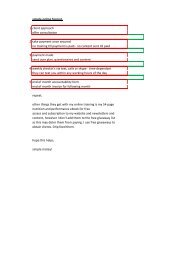Create successful ePaper yourself
Turn your PDF publications into a flip-book with our unique Google optimized e-Paper software.
16. How a muscle grows<br />
How to stimulate muscle growth<br />
There are 3 proven ways to increase muscle mass:<br />
<br />
<br />
<br />
Progressive overload <strong>and</strong> time under tension (TUT)<br />
Damaging the muscle fibres<br />
Cellular fatigue (metabolic stress)<br />
Let’s go over each one individually<br />
Progressive overload <strong>and</strong> time under tension (TUT)<br />
Progressive overload <strong>and</strong> time under tension (TUT) will increase both size <strong>and</strong> growth in muscle<br />
tissue. You want to be progressively increasing the weights you lift over time. Making sure that the<br />
weights go up. For instance, the heavier you can lift the more muscle mass you probably have, so<br />
this is a good indication of both size <strong>and</strong> strength. Recording your results each training session will<br />
help to track this. If the body continually adapts to the weight you’re lifting, then you must push it to<br />
lift heavier over time. This will help to stimulate both muscle growth <strong>and</strong> strength whilst imporving<br />
body composition. Please note that research has shown that when performing mechanical tension, it<br />
is significantly more responsive to a full range of motion. So, avoid half reps <strong>and</strong> incomplete rep<br />
ranges, as this will hinder results, as stated in the “form” section. If you become strong, your body<br />
will look strong. Progressive overload could be one more rep or adding 1.25kg to the bar. It’s all<br />
progress <strong>and</strong> counts greatly. Keeping the muscles under tension will force them to adapt by<br />
increasing the ammout of motor units needed to physically lift the weight.<br />
Damaging the muscle fibres<br />
Damaging muscle fibres is simply the process or by-product of lifting weights under tension<br />
othewrwise known as myofibrillar damage. During a workout, intense lifting causes microscopic<br />
tears to form in the fibre <strong>and</strong> connective tissue of muscles. The body then reacts by releasing what<br />
we call cytokines, an antinflamitory process designed to help repair damaged muscle tissue. That<br />
combined with protein <strong>and</strong> naturally occuruing growth factors like insulin <strong>and</strong> testosterone will help<br />
to create new muscle. These tears fatigue the muscles <strong>and</strong> accumulate in large numbers. With<br />
proper rest <strong>and</strong> sufficient nutrients, the muscles are slowly rebuilt over the following days, but full<br />
repair can take a week or more. The more this happens the more muscle tissue is repaired forming<br />
new muscle. This process is predominantly happening during sleep. Hense its importance.<br />
Cellular fatigue (metabolic stress)<br />
Cellular fatigue is when you push the muscles to failure through repetitive motions which in turn<br />
pushes muscle fibres to their metabolic limit. Cellular damage or metabolic stress occurs when there<br />
is cell swelling around the muscle. You may have heard the term the “pump” a common phrase used<br />
in bodybuilding. Basically, through contracting the muscle repeatedly through repetitions you are<br />
forcing blood into the muscles being worked <strong>and</strong> literally mutating the muscle cells forcing them to<br />
enlargen. You pump blood into the muscle then once the set is finished the blood will start to flow<br />
back out freely, the venous return. Now, if we use a rest time that doesn’t allow full relaxation of the<br />
muscle, when we start the next set some of that blood will still be in the muscle from the first set,<br />
<strong>and</strong> so on <strong>and</strong> so on. Through the sets the muscle will grow larger <strong>and</strong> larger due to more blood<br />
being forced in creating cellular fatigue. If we combine these three elements into our training<br />
programs, we will undoubtedly see positive results in muscle growth.<br />
48




